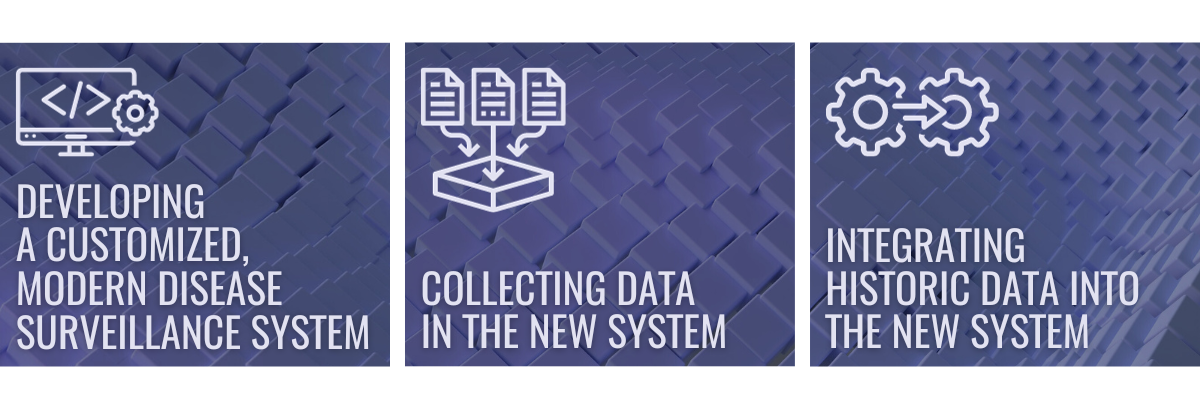developing a modern disease surveillance system
CATEGORY:
Public Health, Federal Government
Cryptosporidium (Crypto) is a microscopic parasite often linked to recreational water in the United States and is one of the leading causes of waterborne disease outbreaks. In the United States alone, there is an average of approximately 823,000 illnesses per year to this pathogen. To effectively manage and respond to cryptosporidiosis cases and outbreaks, public health agencies must collect, consolidate, and analyze data quickly so they can make accurate recommendations to the public to prevent illness. PVM partnered with the Division for Foodborne, Waterborne, and Environmental Diseases (DFWED) at the Centers for Disease Control and Prevention (CDC) to develop a modern surveillance system to better protect our nation’s health and respond to events caused by this parasite.
Using Data for Crypto Surveillance
To effectively protect public health from enteric diseases, CDC relies on quick, accurate data sharing from its jurisdictional partners across the United States about illnesses that could signify an outbreak or concerning trends. For Crypto, this process was outdated and decentralized. Data was coming in through multiple sources: line lists in Excel files, case reports forms in PDFs, emails, etc. Collecting this data, integrating it into multiple data systems, and reconciling it all for effective analyses and recommendations was a daunting and inefficient task. Beyond that, it was difficult to simply access and query the data once transmitted, making managing and tracking outbreaks difficult given the time delays. Sharing information back to partners was just as challenging. And as we have all collectively come to learn through various public health events, the effective transfer and analysis of data is the lynchpin for an effective surveillance and response unit.
Naturally, CDC looked to develop efficient and effective data sharing programs so it could better perform surveillance, manage outbreaks, and make quicker recommendations to the public to prevent further Crypto outbreaks. PVM was up to the task. 
Developing a Customized, Modern Disease Surveillance System
To improve the often manual and time-consuming process of collecting data from hundreds of partners across the country at multiple levels, PVM and CDC partnered to develop a modernized surveillance system specifically focused on Crypto within the CDC’s System for Enteric Disease Response, Investigation, and Coordination (SEDRIC), housed within the CDC’s Data Collation and Integration for Public Health Event Responses (DCIPHER) platform. By building the system within SEDRIC, a system already in use at the agency, the learning curve of new workflows occurred naturally and effortlessly for CDC epidemiologists and their partners. The overarching goal of this modernization system was to streamline what was once a decentralized set of case surveillance management and outbreak response tools into a cohesive, powerful, and centralized tool that enhances investigations with various workflow, analytical, and visualization tools. Every tool PVM built had this mission in mind, culminating in a platform that revamped how surveillance was performed while strictly adhering to what was needed as a foundation, and why certain existing procedures were necessary.
Collecting Data In the New System
With the building blocks of a surveillance system developed, PVM and CDC set their sights on how new data was to be collected using the tools designed for the system. To get around endless emails of case report forms and revisions, PVM replicated the case report form used for Crypto surveillance within SEDRIC itself—jurisdictional partners would no longer need to fill out multiple PDF forms and spreadsheets, or send endless amounts of emails. Instead, they can now simply log into the surveillance system’s secure website and complete forms within-system seamlessly, in real time. And if partners had large sets of data to upload at once? Well, PVM had that covered as well by creating a unique Bulk Upload Tool to ensure that mass amounts of data (case report forms, edits to existing case data, etc.) could be uploaded once in an easy-to-use process. Additionally, in-system backing datasets that stored entered case data could also be used to populate real-time reports and visualizations, eliminating the need for multiple Excel files, SAS codes, and similar redundant data management tools. Epidemiologists shouldn’t be expected to be computer scientists or engineering masterminds—they only need to worry about getting data to where it needs to be. PVM developed the tools to make this easy.
Integrating Historic Data Into the New System
Developing a new surveillance system doesn’t mean that the historic data that stood up surveillance in the past is meaningless. On the contrary, it serves as a baseline for ongoing and future surveillance data that is collected (continuity of analyses, foundations for comparative and longitudinal analyses, and data validation and quality assurance processes, etc.)—a hugely important factor for public health response. PVM lives and breathes surveillance systems and fully understands this concept. As a result, we worked tirelessly to integrate historic data into the newly built system, ensuring no data loss and creating a solid surveillance foundation for years to come. PVM and CDC worked together to ensure that these migrations were completed successfully, and all data was integrated into the new system quickly and accurately.
Unlocking the Power of Crypto Data to Enhance Outbreak Response
The partnership between PVM and CDC resulted in the successful development and implementation of a modern disease surveillance system for Crypto outbreaks. This has had a profound impact on outbreak response and public health recommendations. By accelerating data collection, consolidation, and analysis, this division of CDC can now better respond to events caused by the Crypto parasite.
Need help with public health data modernization, surveillance systems or workflows? Contact PVM today to learn how we can help you unlock the power of your data for good.
.png?width=2156&height=713&name=PVM%20Logo-2021_Light-One-Color%20(1).png)